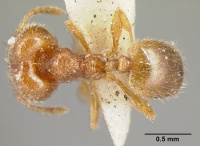Pheidole exigua
| Pheidole exigua | |
|---|---|

| |
| Scientific classification | |
| Kingdom: | Animalia |
| Phylum: | Arthropoda |
| Class: | Insecta |
| Order: | Hymenoptera |
| Family: | Formicidae |
| Subfamily: | Myrmicinae |
| Tribe: | Attini |
| Genus: | Pheidole |
| Species: | P. exigua |
| Binomial name | |
| Pheidole exigua Mayr, 1884 | |
At La Sagasse Bay on Grenada, West Indies, Stefan Cover and I found several colonies of exigua in small pieces of rotten wood on the floor of dry semi-deciduous forest. A colony of the closely similar P. flavens was in a rotten stump on the grounds of an ecotourism resort several hundred meters away. (Wilson 2003)
Identification
See the description in the nomenclature section.
Keys including this Species
Distribution
I have seen material from Costa Rica, Cuba, Puerto Rico, Trinidad, Guyana, French Guiana, and Las Gamas, Santa Cruz, Bolivia, while Kempf (1972b) records it in addition from Pará and Pernambuco in Brazil. (Wilson 2003)
Latitudinal Distribution Pattern
Latitudinal Range: 18.45° to -25.247983°.
| North Temperate |
North Subtropical |
Tropical | South Subtropical |
South Temperate |
- Source: AntMaps
Distribution based on Regional Taxon Lists
Neotropical Region: Barbados, Bolivia, Brazil, Colombia, Costa Rica, Cuba, Ecuador, French Guiana (type locality), Greater Antilles, Guadeloupe, Guyana, Mexico, Netherlands Antilles, Panama, Peru, Puerto Rico, Trinidad and Tobago, Venezuela.
Distribution based on AntMaps
Distribution based on AntWeb specimens
Check data from AntWeb
Countries Occupied
| Number of countries occupied by this species based on AntWiki Regional Taxon Lists. In general, fewer countries occupied indicates a narrower range, while more countries indicates a more widespread species. |

|
Estimated Abundance
| Relative abundance based on number of AntMaps records per species (this species within the purple bar). Fewer records (to the left) indicates a less abundant/encountered species while more records (to the right) indicates more abundant/encountered species. |

|
Biology
Castes
Worker
Minor
Images from AntWeb
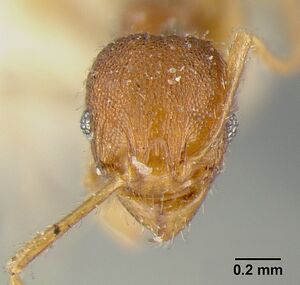 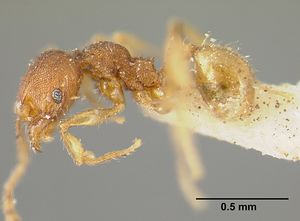  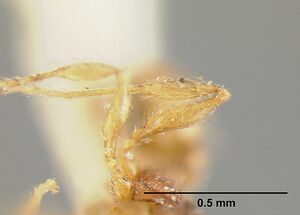 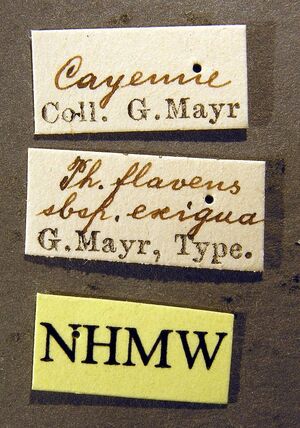
| |
| Paralectotype Pheidole exigua. Worker. Specimen code casent0601289. Photographer John T. Longino, uploaded by California Academy of Sciences. | Owned by NHMV. |
Major
Images from AntWeb
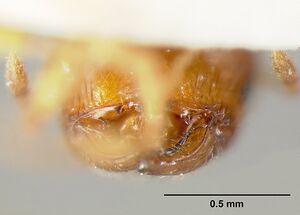 
| |
| Lectotype Pheidole exigua. Worker (major/soldier). Specimen code casent0601288. Photographer John T. Longino, uploaded by California Academy of Sciences. | Owned by NHMV. |
Nomenclature
The following information is derived from Barry Bolton's Online Catalogue of the Ants of the World.
- exigua. Pheidole exigua Mayr, 1884: 36 (s.) FRENCH GUIANA. Wheeler, W.M. 1908a: 135 (w.q.). Subspecies of flavens: Emery, 1894c: 156. Revived status as species: Wilson, 2003: 416.
Unless otherwise noted the text for the remainder of this section is reported from the publication that includes the original description.
Description
From Wilson (2003): A member of the “flavens complex” within the larger flavens group, which includes Pheidole asperithorax, Pheidole breviscapa (=Pheidole perpusilla), Pheidole exigua, Pheidole flavens, Pheidole orbica and Pheidole sculptior and possibly just an extreme variant of flavens. Pheidole exigua is distinguished as follows.
Major: in side and dorsal-oblique views promesonotal profile strongly convex as well as high relative to the metanotum and propodeum, and dropping to the metanotum through a long, almost vertical face; shallow antennal scrobes present, their surfaces smooth and shiny, their anterior third also covered by longitudinal carinulae; intercarinular spaces of head sparsely foveolate to feebly shiny; occiput smooth and shiny; pronotal dorsum mostly covered by transverse carinulae, its surface sparsely foveolate and feebly shiny; posterior half of dorsal head profile flat.
Minor: carinulae confined to head anterior the eyes; almost all of head, mesosoma, and sides of waist foveolate and opaque.
MEASUREMENTS (mm) Lectotype major: HW 0.80, HL 0.84, SL 0.44, EL 0.08, PW 0.36. Paralectotype minor: HW 0.40, HL 0.46, SL 0.38, EL 0.06, PW 0.24.
COLOR Major: body except gaster medium reddish yellow; gaster medium plain yellow, except for rear half of first tergite, which is light brown.
Minor: body and mandibles brownish yellow; other appendages medium plain yellow.
Figure. Upper: lectotype, major. Lower: paralectotype, minor. Scale bars = 1 mm.
Type Material
FRENCH GUIANA: Cayenne (collected by "M. Jelski," no first name given). Naturhistorisches Museum Wien, Vienna - as reported in Wilson (2003)
Etymology
L exigua, small, trifling. (Wilson 2003)
References
- Wilson, E. O. 2003. Pheidole in the New World: A dominant, hyperdiverse ant genus. Harvard University Press, Cambridge, MA. (page 416, Revived from synonymy, and raised to species, fig. major, minor described)
- Albuquerque, E., Prado, L., Andrade-Silva, J., Siqueira, E., Sampaio, K., Alves, D., Brandão, C., Andrade, P., Feitosa, R., Koch, E., Delabie, J., Fernandes, I., Baccaro, F., Souza, J., Almeida, R., Silva, R. 2021. Ants of the State of Pará, Brazil: a historical and comprehensive dataset of a key biodiversity hotspot in the Amazon Basin. Zootaxa 5001, 1–83 (doi:10.11646/zootaxa.5001.1.1).
- Emery, C. 1894d. Studi sulle formiche della fauna neotropica. VI-XVI. Bull. Soc. Entomol. Ital. 26: 137-241 (page 156, subspecies of flavens)
- Franco, W., Ladino, N., Delabie, J.H.C., Dejean, A., Orivel, J., Fichaux, M., Groc, S., Leponce, M., Feitosa, R.M. 2019. First checklist of the ants (Hymenoptera: Formicidae) of French Guiana. Zootaxa 4674, 509–543 (doi:10.11646/zootaxa.4674.5.2).
- Kempf, W. W. 1972b. Catálogo abreviado das formigas da região Neotropical. Stud. Entomol. 15: 3–344.
- Mayr, G. 1884. [Untitled. Descriptions of eight new species.]. Pp. 31-38 in: Radoszkowsky, O. Fourmis de Cayenne Française. Tr. Rus. Entomol. Obshch. 18:30-39. (page 36, soldier described)
- Meurgey, F. 2020. Challenging the Wallacean shortfall: A total assessment of insect diversity on Guadeloupe (French West Indies), a checklist and bibliography. Insecta Mundi 786: 1–183.
- Wetterer, J.K. 2021. Ants (Hymenoptera, Formicidae) of St. Vincent, West Indies. Sociobiology 68, e6725 (doi:10.13102/sociobiology.v68i2.6725).
- Wheeler, W. M. 1908a. The ants of Porto Rico and the Virgin Islands. Bull. Am. Mus. Nat. Hist. 24: 117-158 (page 135, worker, queen described)
References based on Global Ant Biodiversity Informatics
- Bezdeckova K., P. Bedecka, and I. Machar. 2015. A checklist of the ants (Hymenoptera: Formicidae) of Peru. Zootaxa 4020 (1): 101–133.
- Boer P. 2019. Ants of Curacao, species list. Accessed on January 22 2019 at http://www.nlmieren.nl/websitepages/SPECIES%20LIST%20CURACAO.html
- De Souza Holanda P. M. 2016. Efeitos da variacao do lencol: freatico em assembleias de formigas (Hymenoptera: Formicidae) que vivem na serapilheira na reserva Adolpho Ducke, Manaus, Am. Master's Thesis Universidade Federal do Amazonas, 48 pages.
- Emery C. 1894. Studi sulle formiche della fauna neotropica. VI-XVI. Bullettino della Società Entomologica Italiana 26: 137-241.
- Fernández, F. and S. Sendoya. 2004. Lista de las hormigas neotropicales. Biota Colombiana Volume 5, Number 1.
- Fontenla J. L., and J. Alfonso-Simonetti. 2018. Classification of Cuban ants (Hymenoptera: Formicidae) into functional groups. Poeyana Revista Cubana de Zoologia 506: 21-30.
- Franco W., N. Ladino, J. H. C. Delabie, A. Dejean, J. Orivel, M. Fichaux, S. Groc, M. Leponce, and R. M. Feitosa. 2019. First checklist of the ants (Hymenoptera: Formicidae) of French Guiana. Zootaxa 4674(5): 509-543.
- Galkowski C. 2016. New data on the ants from the Guadeloupe (Hymenoptera, Formicidae). Bull. Soc. Linn. Bordeaux 151, 44(1): 25-36.
- Gregg R. E. 1959. Key to the species of Pheidole (Hymenoptera: Formicidae) in the United States. Journal of the New York Entomological Society 66: 7-48.
- Kempf, W.W. 1972. Catalago abreviado das formigas da regiao Neotropical (Hym. Formicidae) Studia Entomologica 15(1-4).
- LaPolla, J.S. and S.P. Cover. 2005. New species of Pheidole (Hymenoptera: Formicidae) from Guyana, with a list of species known from the country. Tranactions of the American Entomological Society 131(3-4):365-374
- Radoszkowsky O. 1884. Fourmis de Cayenne Française. Trudy Russkago Entomologicheskago Obshchestva 18: 30-39.
- Reyes J.L. 2005. Inventario de la coleccion de hormigas (Hymenoptera: Formicidae) del centro oriental de ecosistemas y biodiversidad, Santiago de Cuba, Cuba. Boletín Sociedad Entomológica Aragonesa 36: 279-283.
- Reyes, J. L. "Inventario de la colección de hormigas (Hymenoptera: Formicidae) del Centro Oriental de Ecosistemas y Biodiversidad, Santiago de Cuba, Cuba." Boletín de la Sociedad Aragonesa 36 (2005): 279-283.
- Torres J.A. 1984. Niches and Coexistence of Ant Communities in Puerto Rico: Repeated Patterns. Biotropica 16(4): 284-295.
- Torres, Juan A. and Roy R. Snelling. 1997. Biogeography of Puerto Rican ants: a non-equilibrium case?. Biodiversity and Conservation 6:1103-1121.
- Vasconcelos, H.L. and J.M.S. Vilhena. 2006. Species turnover and vertical partitioning of ant assemblages in the Brazilian Amazon: A comparison of forests and savannas. Biotropica 38(1):100-106.
- Vasconcelos, H.L., J.M.S. Vilhena, W.E. Magnusson and A.L.K.M. Albernaz. 2006. Long-term effects of forest fragmentation on Amazonian ant communities. Journal of Biogeography 33:1348-1356
- Wheeler W. M. 1908. The ants of Porto Rico and the Virgin Islands. Bulletin of the American Museum of Natural History 24: 117-158.
- Wheeler W. M. 1916. Ants collected in British Guiana by the expedition of the American Museum of Natural History during 1911. Bulletin of the American Museum of Natural History 35: 1-14.
- Wilson, E.O. 2003. Pheidole in the New World: A Dominant, Hyperdiverse Genus. Harvard University Press

